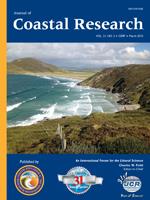Hwang, S.W.; Lee, T.W.; Hwang S.D.; Lee, E.K., and Yoo, J.M. 2015. Habitat use patterns of Chelon haematocheilus, as revealed by Sr:Ca ratios in otoliths.
We measured Sr:Ca ratios in otoliths to examine the habitat use patterns of 50 Chelon haematocheilus collected from two estuaries of the Geum River and the Mangyeong River on the midwest coast of South Korea. The average ratio was 5 × 10−3 ± 0.6 × 10−3 (mean ± SD) in the core of the otolith and ranged from 3 × 10−3 to 7 × 10−3 in the opaque zone surrounding the core. We applied the criteria used to analyze otoliths in the closely related species Mugil cephalus in a previous study and concluded from the otolith Sr:Ca ratios that C. haematocheilus spawns and grows in brackish water during the early part of its life cycle. Most fish showed otolith Sr:Ca ratios ranging from 3 × 10−3 to 7 × 10−3, indicating that they primarily live in brackish water. Some fish had ratios outside that range, indicating that they had potentially spent time in the upper, less-saline or lower, more-saline parts of the estuaries. Of C. haematocheilus in the Mangyeong River estuary, 34.8% had inhabited freshwater, but of those in the Geum River estuary, where a dike causes the water to be more saline, only 22.2% had inhabited freshwater. The findings of our study offer useful new information on the habitat choice of C. haematocheilus, allowing more sustainable use of the species.





